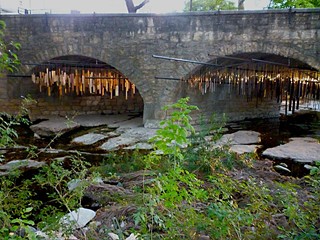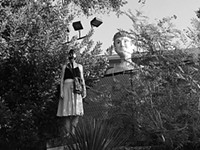All Over Creation: Here Today ...
Site-specific art that exists so briefly says a lot about Austin
By Robert Faires, Fri., Oct. 28, 2011
The transformation of the space was as stunning as promised. Suspended under a bridge over Waller Creek were three massive mobiles constructed of hundreds of long, narrow bars, one for each arch, each with bars made of a different material: one glass, one metal, one wood. The mobiles dangled from 40-foot steel rods hanging under the bridge and attached to steel armatures that followed the curve of the arches but floated below them. With powerful lights directed on them, the mobiles glowed as they hovered between the arching stone of the bridge and the flat stone and water of the creek bed. They turned what was already a lovely spot, with the graceful shapes and natural materials of the manmade structure in quiet conversation with the creek and its banks, into a space not only more beautiful but also dynamic, the mobiles activating the open spaces under the bridge like a light switch being thrown. The new materials in contrast to the existing ones prompted a greater awareness of the objects around you, their forms and textures and shades and how they play off one another. And the way the mobiles filled what was ordinarily empty air heightened your sensitivity to space, leading you to discover new relationships between objects that might have previously gone unnoticed.
The installation also heightened your sensitivity to time, because it had been made quite clear to the crowd behind the Etter-Harbin Alumni Center that it was temporary. Created for a University of Texas symposium (see "Music in Architecture – Architecture in Music," Oct. 21), it was intended to remain in place for just one performance of Matthew Teodori's original composition "seeing times are not hidden" on Wednesday, Oct. 19. So as you watched and listened to Teodori and Cullen Faulk and Adam Bedell, his colleagues in the percussion ensemble Line Upon Line, slowly make their way through the mobiles, playing them like chimes – the ring of glass on glass, metal on metal, and wood on wood sounding so distinctly and mingling in the dimming light – you were drawn to think of what a fleeting experience this was. Once the sun set, it would be done. All those months of work by the musicians and their architectural collaborators Norma Yancey and Emily Little – I recall running into some of them looking at the site in May – the untold hours of design, calculation, construction, and installation, and what would be left to show for it? Nothing. (As it turned out, a second performance took place at 11pm that night, but still ....)
As I reflected on this, ghosts began to dance among the mobiles and musicians, the shades of another performance that had taken place in the same spot two and a half years earlier: The Shape of White, a collaboration among choreographer Andee Scott, scenic designer Yvonne Boudreaux, and technical director Chih-Feng Chen for the UT Department of Theatre & Dance's 2009 Cohen New Works Festival. That, too, had been an elaborate alteration of the site with projections on the underside of the bridge, performers in chairs among the trees, and dancers suspended under the bridge's arches, much like the mobiles hanging there in the present. With that piece, as with this one, so much work had gone into its creation, into the metamorphosis of this site into a performing space, but after a mere handful of showings, all was restored to its original state, no trace of transformation to be found.
So why channel so much energy into something so ephemeral? The question might well be applied to all the performing arts. In this field, everything comes and goes quickly. Even productions that manage runs of months or years eventually become Prospero's "insubstantial pageant faded," leaving "not a rack behind." Still, performances that fully rework sites in extravagant ways for only a few hours provoke our curiosity most urgently – and our city boasts more than its share of such projects. (See "30 Sites Around Austin That Were Transformed Into Stages," Year 30.) I suspect that has something to do with our sense of place, what we love about Austin and why we love to talk so much about it. We feel a need to examine and affirm our relationship with this place, and these transitory transformations of spaces here are one way to do that. We take this environment and make something new of it, something that grows out of our affection for it and the creative energy that this city inspires in us. In it, we renew our connection to Austin.
And it's a powerful way to do that, largely because the effort involved is so great and the results so short-lived. We give so much then let it go. Our city has been historically represented by images of the Capitol and the UT Tower, structures of stone that have stood unchanged for generations. But I wonder if a better symbol for Austin wouldn't be the phantoms of its bold, creative site-specific artworks that transform the city's face ever so briefly but leave it forever changed in our minds.










